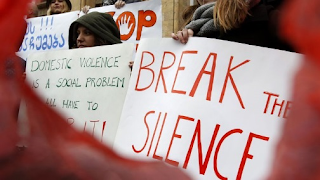A Qualitative Analysis of the Link Between Violence Against Women and Children And Quality of RMNCAH Outcomes in 8 African Countries: Tom Muyunga-Mukasa, Gonzaga Kelly Kyagaba & Charles Lwande.
Domestic Violence is a barrier for quality maternal nutrition
and RMNCAH outcomes and subverts efforts to achieve SDG 2, 3 & 5. Violence
manifests in: structural, political and cultural systems; bodily injuries and
physical assault. At individual level this presents as: pregnancy before 18
years; malnourishment in utero, obstructed labour; Fistula; Unplanned
pregnancies; Sexually Transmitted Infections.
Background:
RMNCAH outcomes such as ensuring
safer, optimal birth outcomes, maternal well-being, nutrition and autonomy for
women to have opportunities for self-care are
linked to reduced risk to Violence. This study explored negative stereotypes of
hegemonic masculinity and the social structures linked to it. An exploration of
8 Sub-Saharan African countries found 3 country specific definitive social
structures impacting the stereotypes, i.e., Enabling; Restrictive; and
Hindering structures.
Methods:
A meta-analysis of data and research findings from 2015-2019 of
the relationship between violence against women and violence against
children is reflected
in: Trauma Informed
Care (TIC); comprehensive
RMNCAH strategies such as IMNI, A/PNC,
KMC, perinatal death review, and/or integrated maternal and perinatal death
surveillance and response (MPDSR) processes; enforcement of legal gender
equality; religious and traditional support for respect and dignity of women;
uptake of gender specific prevention services; Domestic Violence (DV) reports
and HIV Prevention. 170 articles and reports were identified but 80 met
inclusion criteria.
Results:
Partners who are
not emancipated about
maternal nutrition and
health don’t contribute
to women well-being and safer, optimal birth outcomes. Stereotypes of
hegemonic masculinity exist in all 8 countries studied. Politics, religion and
tradition influence risk reduction, e.g., enforcement of legal gender
equality, political commitment and accountable judiciary ensure women can
report abuses. Male dominance beliefs; traditions e.g. Female genital cutting, rape, precarious
toxic masculinity, indifference to expectant mother health by males,
stigmatization of frequent clinic visits; and gender of breadwinner are linked
to violence-related risks.
Compared to all 8 countries, Rwanda, Ethiopia and Kenya have a
hindering structure promoting significant risk reduction with institutions
fostering increased rule of law, political commitment to RMNCAH outcomes,
enforcement and risk-reduction consciousness. Uganda and Tanzania have a
restrictive structure characterized with legal loopholes, irregular enforcement
and ambivalent political commitment to address acts of violence against women
and children. In Senegal, South Africa and Nigeria political, religious and
traditional factors blatantly backing traditional negative stereotypes of
hegemonic masculinity foster
violence enabling structures
entrenching repressive acts
and hate crimes against women and children. In all
countries however, Delivery room reception; level of Health information
Management skills; HIV criminalization; affinity and sensitivity to quality
health by all people; stigma around attending clinics by males; negotiating for
safer sex by women which is circumscribed as a threat to male dominance,
subvert or support optimal RMNCAH goals.
Conclusions:
Safer and optimal birth outcomes and achievement of the
Sustainable Development Goals (SDGs) are connected. These in turn are dependent
on over-arching social, political and economic dispensation. These manifest as:
economic autonomy, religion and traditional backing which contribute
effectively to overall risk-reduction as far as maternal nutrition and health
are concerned. Contexts hindering violence prevail where state-led commitment
thrives and these have far reaching benefits e.g., more people demand, access
and benefit from RMNCAH outcomes. Effective and quality RMNCAH
programming in the countries studied will be effective if it is designed to
involve males and addresses hegemonic masculinity practices too. Mortality
implementation audits need to be dis-aggregated to reflect causes of and
contributing factors to deaths such as assault to women and lack of male involvement
in practices promoting optimal birth outcomes.
At SAI we are committed to continuous engagement in social
impact research in order to promote RMNCAH, SGBV/VAC, and SRHR Including HIV
prevention continuum. We believe this will contribute to accomplishment of our
organization mission of mobilizing
men to participate in mechanisms that promote free, healthy and quality living
for themselves, spouses and children within their domicile communities in order
to achieve positive sustainable social, economic and health outcomes and the Sustainable Development Goals 2, 3 & 5.
We pride in raising the next generation of men to engage in
building a safe and prosperous family, community and the nation at large!



Comments
Post a Comment